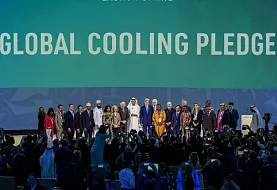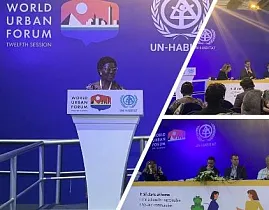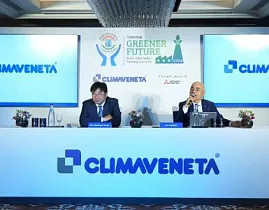The 14th Clean Energy Ministerial Meeting and 8th Mission Innovation Meeting (#CEM14MI8) held in July, in Goa, where Minsters, high level non-state actors and CEOs rallied momentum for global action and an increased ambition on cooling. As part of this they showed strong support for the Global Cooling Pledge which aims to coordinate international action on sustainable cooling as we head towards COP28.
COP28 president designate Dr. Sultan Al Jaber called on all countries to join the Global Cooling Pledge, which seeks to expand the availability of cooling systems to protect the most vulnerable communities from extreme heat.
Ravi Purushothaman, President, India Region, Danfoss, was also present at #CEM14MI8, said: “The Global Cooling Pledge is very timely. Cooling must no longer be seen as a luxury; it is a public health necessity. Yet, there remains an alarming lack of understanding of the sheer impact of cooling. Cooling can also make a substantial contribution to reducing greenhouse gas emissions if it is given the attention it deserves. Therefore, we encourage governments to support the Pledge as we go towards COP28.”
Since 2000, the demand for space cooling has been increasing by as much as 4% per year. It is the fastest-growing cause for energy use in buildings. By increasing the energy efficiency of air-conditioning units, energy consumption can be significantly reduced.
Benefits of district cooling, go even further. It is one of the most efficient ways to decarbonize our buildings. It supports the transition towards more climate friendly refrigerants and avoids heat islands in cities. And it facilitates the phase-in of renewable energies due to its thermal storage capacities, thus improving air quality.
Ravi Purushothaman says: “District cooling is a much more efficient way of cooling our cities than the typical AC unit we have grown familiar with. Singapore, for example, has the world’s largest district cooling system, and has reduced its energy bill by 40%, while also reducing the country’s emissions by the equivalent of 10,000 cars per year. In the GIFT city in Gujarat, here in India, power requirements could be halved with district cooling as opposed to conventional air-conditioning. The solutions are here, now is the time for taking action.”
Dan Jorgensen, Danish Minister for Development Cooperation and Global Climate Policy, also spoke at the event. He drew attention:
-
Today, we are experiencing the hottest days ever recorded on the planet. These unprecedented temperatures are probably the highest in at least 100,000 years. Unfortunately, this is not a one-time occurrence. Experts warn us that this heat record could be broken multiple times in the years ahead as well.
-
With such record temperatures, we need to discuss cooling. Access to cooling plays a vital role for the well-being of human beings. It is used to keep vaccines cold and food fresh. Ten new cooling devices are sold across the globe every second.
- Today, cooling has become the second fastest-growing contributor to electricity usage, and it is projected that global consumption of cooling will triple by the year 2050.
- A range of measures must be taken: 1) We need to implement energy performance standards for appliances. This will mean that all new appliances are energy efficient and that the pace of rising energy consumption can be more measured. 2) We need to improve building codes. These can help secure that future buildings will become more energy efficient to cool down.
- And we need to establish efficient and renewable cold chains for food and medicine. These will enable many more people access to fresh notorious meals and improved health care.





